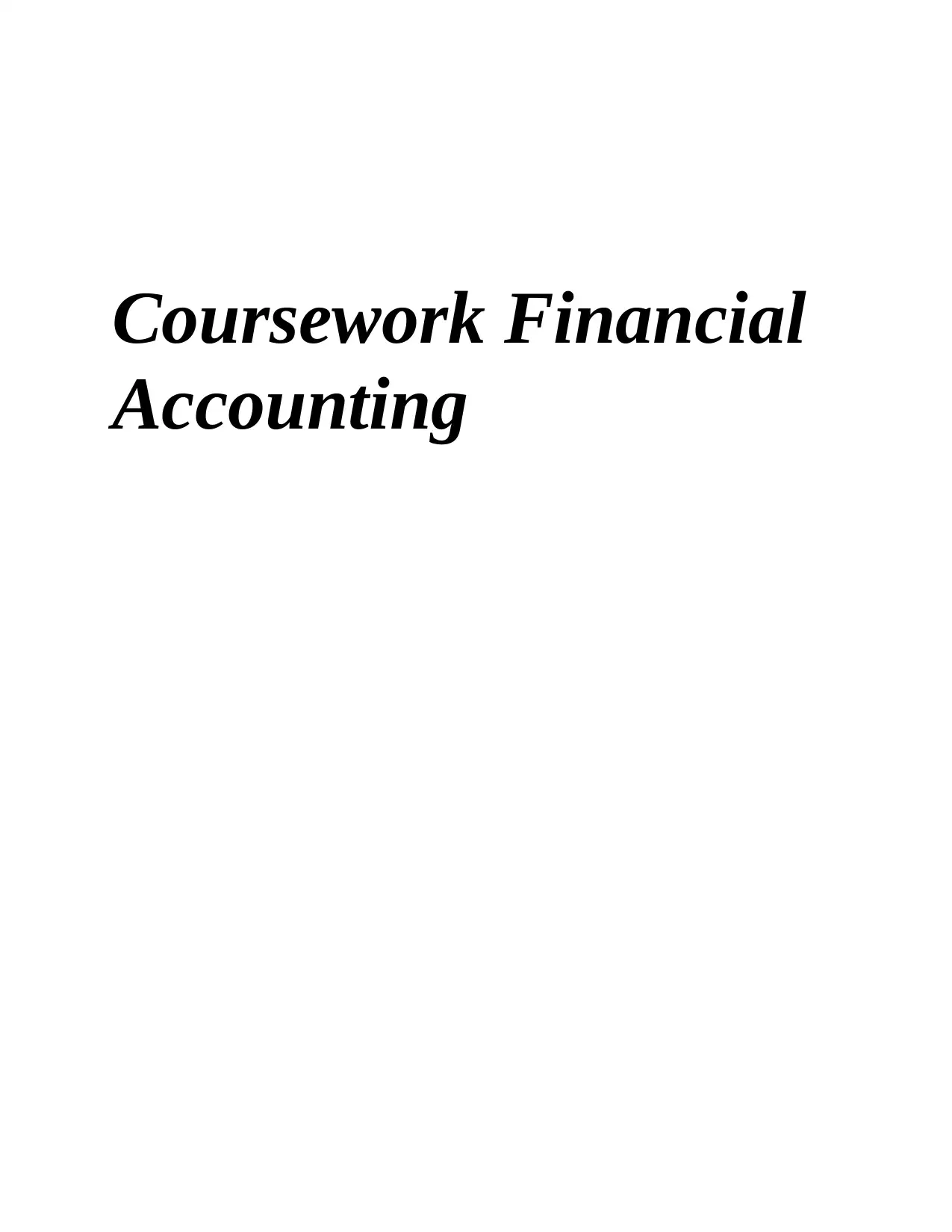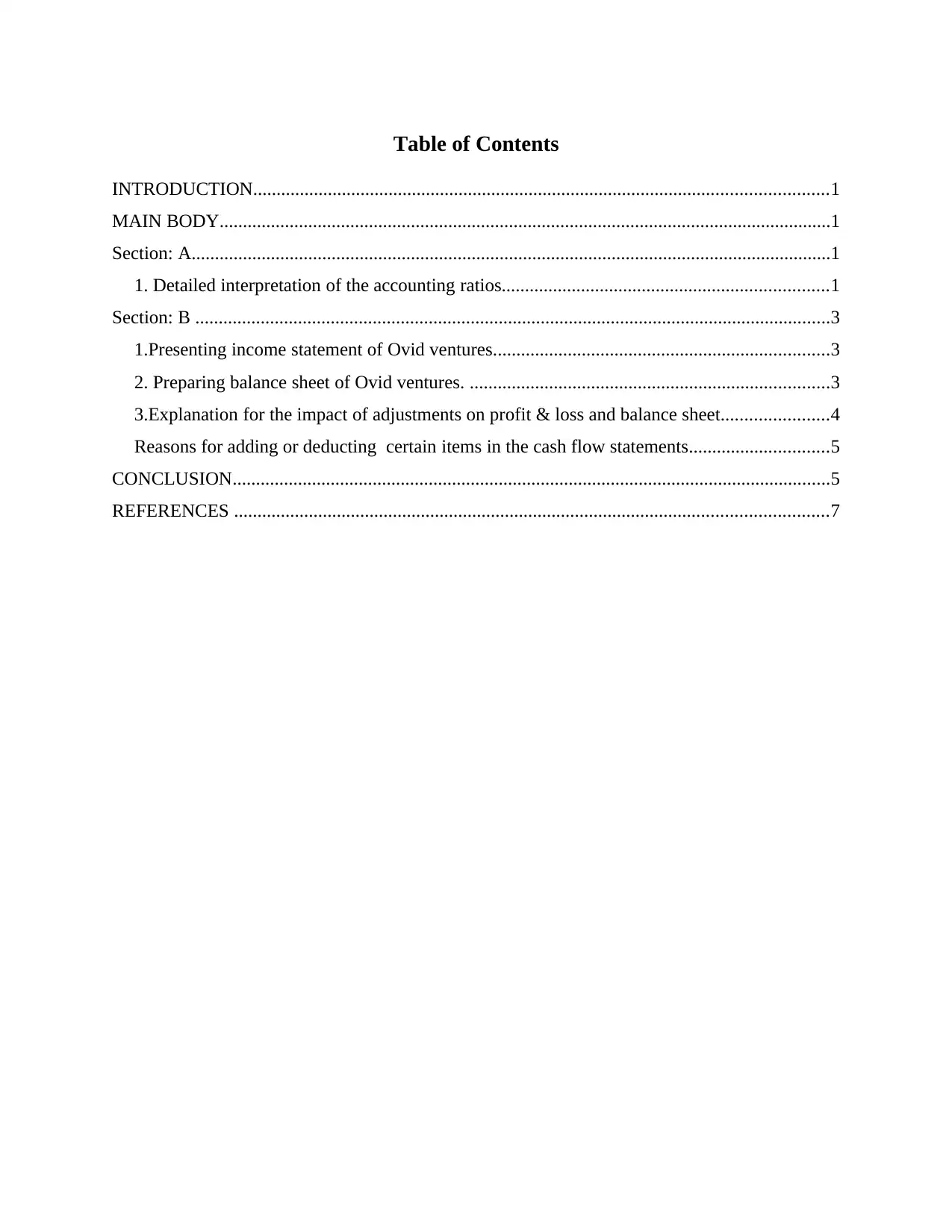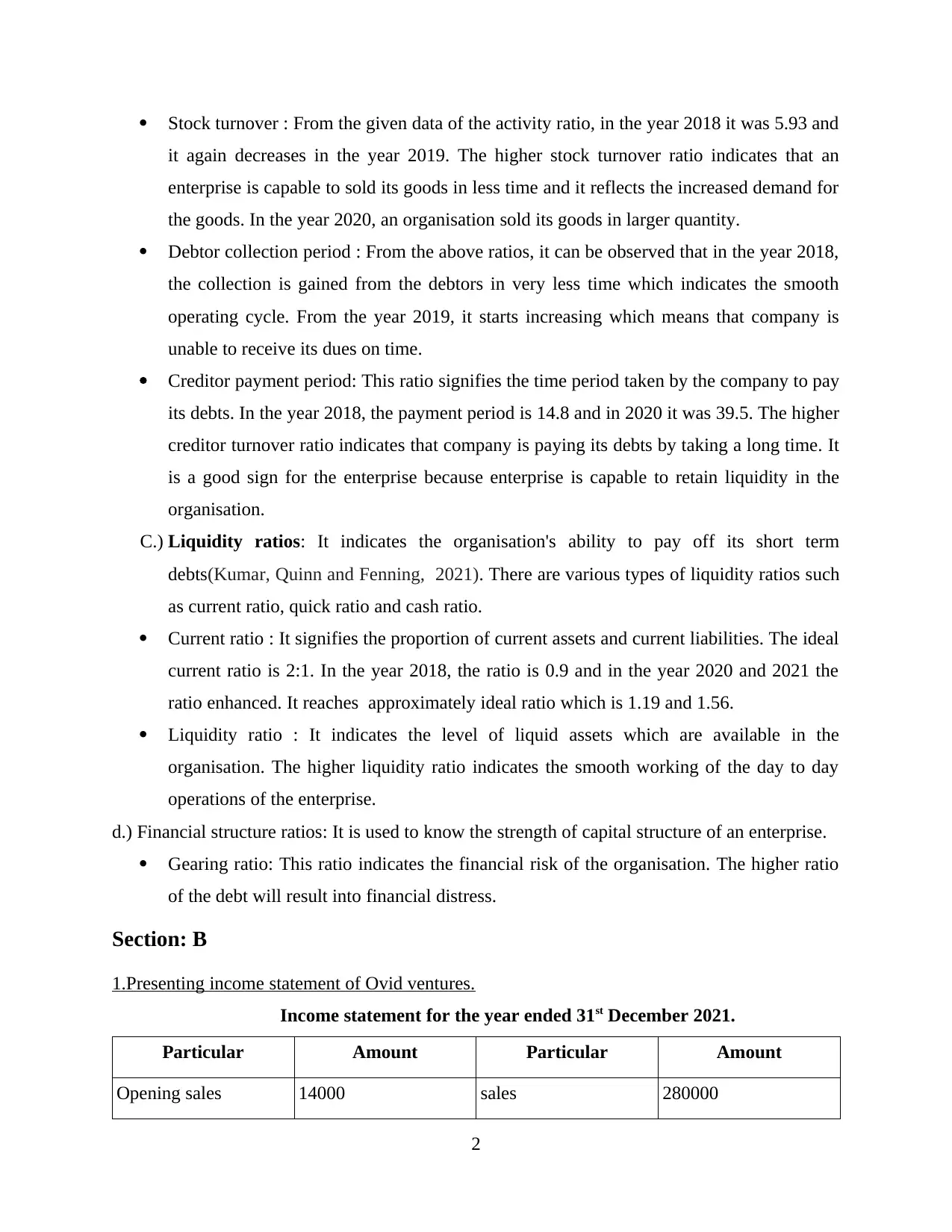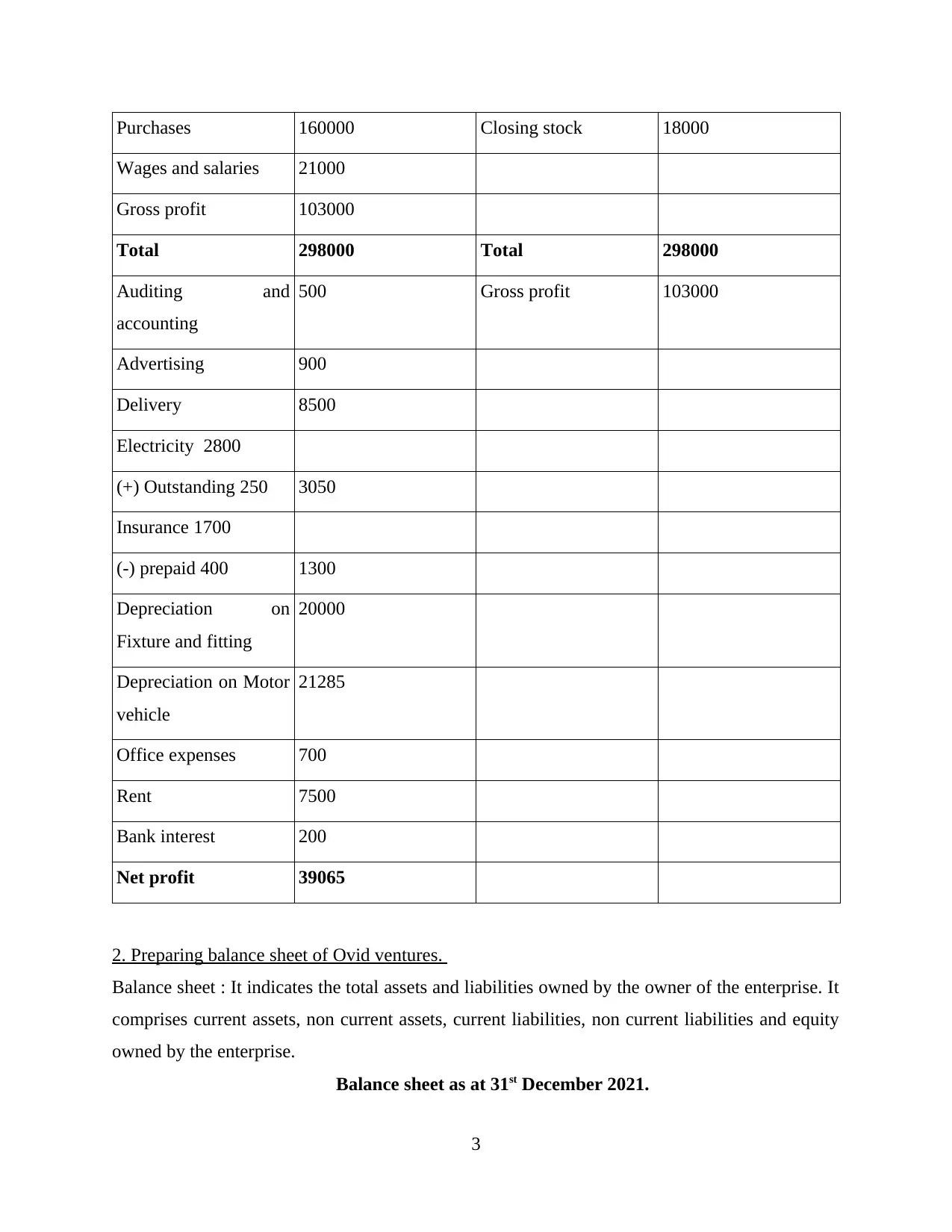Financial Accounting Coursework: Ratio Analysis and Ovid Ventures
VerifiedAdded on 2023/06/12
|9
|2006
|475
Report
AI Summary
This report provides a comprehensive analysis of financial accounting principles, focusing on ratio analysis and the preparation of financial statements. Section A includes a detailed interpretation of various accounting ratios, such as profitability, efficiency, liquidity, and financial structure ratios, using data from ASOS spanning from 2018 to 2021. Section B involves the creation of an income statement and balance sheet for Ovid Ventures as of December 31, 2021, with explanations of income, expenses, and adjustments. The report also discusses the impact of prepaid and accrued expenses and income on financial statements, as well as the rationale behind adding or deducting specific items, like depreciation and disposal of non-current assets, in cash flow statements. The report concludes by emphasizing the importance of financial accounting for strategic and financial decision-making.

Coursework Financial
Accounting
Accounting
Paraphrase This Document
Need a fresh take? Get an instant paraphrase of this document with our AI Paraphraser

Table of Contents
INTRODUCTION...........................................................................................................................1
MAIN BODY...................................................................................................................................1
Section: A.........................................................................................................................................1
1. Detailed interpretation of the accounting ratios......................................................................1
Section: B ........................................................................................................................................3
1.Presenting income statement of Ovid ventures........................................................................3
2. Preparing balance sheet of Ovid ventures. .............................................................................3
3.Explanation for the impact of adjustments on profit & loss and balance sheet.......................4
Reasons for adding or deducting certain items in the cash flow statements..............................5
CONCLUSION................................................................................................................................5
REFERENCES ...............................................................................................................................7
INTRODUCTION...........................................................................................................................1
MAIN BODY...................................................................................................................................1
Section: A.........................................................................................................................................1
1. Detailed interpretation of the accounting ratios......................................................................1
Section: B ........................................................................................................................................3
1.Presenting income statement of Ovid ventures........................................................................3
2. Preparing balance sheet of Ovid ventures. .............................................................................3
3.Explanation for the impact of adjustments on profit & loss and balance sheet.......................4
Reasons for adding or deducting certain items in the cash flow statements..............................5
CONCLUSION................................................................................................................................5
REFERENCES ...............................................................................................................................7

INTRODUCTION
Financial accounting is the process in which recording, summarising and reporting the
transactions of business which takes over a period of time. There are various financial statements
such as balance sheet, income statement and cash flow statements which helps in analysing the
financial performance of the organisation(Bhadauria and et.al., 2019).. This report is divided into
two sections. In section one, it includes the report of ASOS on the basis of financial performance
of 2018 to 2021. In section B, it includes the preparation of income statement and balance sheet
on 31st December 2021. It includes the explanation of the various expenses and income. The
adjustment in the profit& loss and balance sheet is also included in this report. It also
encompasses the brief explanation of the some items such as depreciation, disposal of non
current asset and increase in inventories is added or deducted from the cash flow statements.
MAIN BODY
Section: A
1. Detailed interpretation of the accounting ratios
Financial ratio : It is defined as a relative magnitude which is taken from the enterprise
financial statements. There are various ratios such as liquidity ratios, profitability ratios, activity
ratio and solvency ratios(Ahmed and Siddiqui, 2021) The interpretation of the ratios are as
follows:
a.) Profitability ratios: It is a measure used by the enterprise which reflects the ability of
organisation to generate profits. There are various ratios included in the profitability ratios such
as return on capital employed, earnings per share, gross profit etc.
Return on capital employed : from the above given ROCE of four consecutive years, it
can be interpreted that in the year 2018, the ratio was 22.72%. The higher ROCE
indicates that organisation is making effective use of capital which ultimately increases
the profit of the ASOS. From the year 2019, it started declining and in the year 2021 it
reached to 9.39%.
B.) Efficiency ratios: This ratio states that how effectively an enterprise is utilising its assets and
capable to derive revenue from the same(Carrión, 2018). The interpretation of the activity ratios
can be described as given below:
1
Financial accounting is the process in which recording, summarising and reporting the
transactions of business which takes over a period of time. There are various financial statements
such as balance sheet, income statement and cash flow statements which helps in analysing the
financial performance of the organisation(Bhadauria and et.al., 2019).. This report is divided into
two sections. In section one, it includes the report of ASOS on the basis of financial performance
of 2018 to 2021. In section B, it includes the preparation of income statement and balance sheet
on 31st December 2021. It includes the explanation of the various expenses and income. The
adjustment in the profit& loss and balance sheet is also included in this report. It also
encompasses the brief explanation of the some items such as depreciation, disposal of non
current asset and increase in inventories is added or deducted from the cash flow statements.
MAIN BODY
Section: A
1. Detailed interpretation of the accounting ratios
Financial ratio : It is defined as a relative magnitude which is taken from the enterprise
financial statements. There are various ratios such as liquidity ratios, profitability ratios, activity
ratio and solvency ratios(Ahmed and Siddiqui, 2021) The interpretation of the ratios are as
follows:
a.) Profitability ratios: It is a measure used by the enterprise which reflects the ability of
organisation to generate profits. There are various ratios included in the profitability ratios such
as return on capital employed, earnings per share, gross profit etc.
Return on capital employed : from the above given ROCE of four consecutive years, it
can be interpreted that in the year 2018, the ratio was 22.72%. The higher ROCE
indicates that organisation is making effective use of capital which ultimately increases
the profit of the ASOS. From the year 2019, it started declining and in the year 2021 it
reached to 9.39%.
B.) Efficiency ratios: This ratio states that how effectively an enterprise is utilising its assets and
capable to derive revenue from the same(Carrión, 2018). The interpretation of the activity ratios
can be described as given below:
1
⊘ This is a preview!⊘
Do you want full access?
Subscribe today to unlock all pages.

Trusted by 1+ million students worldwide

Stock turnover : From the given data of the activity ratio, in the year 2018 it was 5.93 and
it again decreases in the year 2019. The higher stock turnover ratio indicates that an
enterprise is capable to sold its goods in less time and it reflects the increased demand for
the goods. In the year 2020, an organisation sold its goods in larger quantity.
Debtor collection period : From the above ratios, it can be observed that in the year 2018,
the collection is gained from the debtors in very less time which indicates the smooth
operating cycle. From the year 2019, it starts increasing which means that company is
unable to receive its dues on time.
Creditor payment period: This ratio signifies the time period taken by the company to pay
its debts. In the year 2018, the payment period is 14.8 and in 2020 it was 39.5. The higher
creditor turnover ratio indicates that company is paying its debts by taking a long time. It
is a good sign for the enterprise because enterprise is capable to retain liquidity in the
organisation.
C.) Liquidity ratios: It indicates the organisation's ability to pay off its short term
debts(Kumar, Quinn and Fenning, 2021). There are various types of liquidity ratios such
as current ratio, quick ratio and cash ratio.
Current ratio : It signifies the proportion of current assets and current liabilities. The ideal
current ratio is 2:1. In the year 2018, the ratio is 0.9 and in the year 2020 and 2021 the
ratio enhanced. It reaches approximately ideal ratio which is 1.19 and 1.56.
Liquidity ratio : It indicates the level of liquid assets which are available in the
organisation. The higher liquidity ratio indicates the smooth working of the day to day
operations of the enterprise.
d.) Financial structure ratios: It is used to know the strength of capital structure of an enterprise.
Gearing ratio: This ratio indicates the financial risk of the organisation. The higher ratio
of the debt will result into financial distress.
Section: B
1.Presenting income statement of Ovid ventures.
Income statement for the year ended 31st December 2021.
Particular Amount Particular Amount
Opening sales 14000 sales 280000
2
it again decreases in the year 2019. The higher stock turnover ratio indicates that an
enterprise is capable to sold its goods in less time and it reflects the increased demand for
the goods. In the year 2020, an organisation sold its goods in larger quantity.
Debtor collection period : From the above ratios, it can be observed that in the year 2018,
the collection is gained from the debtors in very less time which indicates the smooth
operating cycle. From the year 2019, it starts increasing which means that company is
unable to receive its dues on time.
Creditor payment period: This ratio signifies the time period taken by the company to pay
its debts. In the year 2018, the payment period is 14.8 and in 2020 it was 39.5. The higher
creditor turnover ratio indicates that company is paying its debts by taking a long time. It
is a good sign for the enterprise because enterprise is capable to retain liquidity in the
organisation.
C.) Liquidity ratios: It indicates the organisation's ability to pay off its short term
debts(Kumar, Quinn and Fenning, 2021). There are various types of liquidity ratios such
as current ratio, quick ratio and cash ratio.
Current ratio : It signifies the proportion of current assets and current liabilities. The ideal
current ratio is 2:1. In the year 2018, the ratio is 0.9 and in the year 2020 and 2021 the
ratio enhanced. It reaches approximately ideal ratio which is 1.19 and 1.56.
Liquidity ratio : It indicates the level of liquid assets which are available in the
organisation. The higher liquidity ratio indicates the smooth working of the day to day
operations of the enterprise.
d.) Financial structure ratios: It is used to know the strength of capital structure of an enterprise.
Gearing ratio: This ratio indicates the financial risk of the organisation. The higher ratio
of the debt will result into financial distress.
Section: B
1.Presenting income statement of Ovid ventures.
Income statement for the year ended 31st December 2021.
Particular Amount Particular Amount
Opening sales 14000 sales 280000
2
Paraphrase This Document
Need a fresh take? Get an instant paraphrase of this document with our AI Paraphraser

Purchases 160000 Closing stock 18000
Wages and salaries 21000
Gross profit 103000
Total 298000 Total 298000
Auditing and
accounting
500 Gross profit 103000
Advertising 900
Delivery 8500
Electricity 2800
(+) Outstanding 250 3050
Insurance 1700
(-) prepaid 400 1300
Depreciation on
Fixture and fitting
20000
Depreciation on Motor
vehicle
21285
Office expenses 700
Rent 7500
Bank interest 200
Net profit 39065
2. Preparing balance sheet of Ovid ventures.
Balance sheet : It indicates the total assets and liabilities owned by the owner of the enterprise. It
comprises current assets, non current assets, current liabilities, non current liabilities and equity
owned by the enterprise.
Balance sheet as at 31st December 2021.
3
Wages and salaries 21000
Gross profit 103000
Total 298000 Total 298000
Auditing and
accounting
500 Gross profit 103000
Advertising 900
Delivery 8500
Electricity 2800
(+) Outstanding 250 3050
Insurance 1700
(-) prepaid 400 1300
Depreciation on
Fixture and fitting
20000
Depreciation on Motor
vehicle
21285
Office expenses 700
Rent 7500
Bank interest 200
Net profit 39065
2. Preparing balance sheet of Ovid ventures.
Balance sheet : It indicates the total assets and liabilities owned by the owner of the enterprise. It
comprises current assets, non current assets, current liabilities, non current liabilities and equity
owned by the enterprise.
Balance sheet as at 31st December 2021.
3

Cost £ Accumulated depreciation £ Carrying amount £
Non current assets:
Fixtures and fittings 80000 (16000+8000)=24000 24000
Motor vehicle 25000 (25000-1350*10%)=2365
(25000-2365) 22635
Total 28635
Current asset:
Bank 1500
Prepayment for insurance 300
Debtors 41350
Total 43150 43510
Current liabilities:
Creditors 8900
8900 8900
Net Current Assets 9610
Long term liabilities:
Long term bank loan 7400 -7400
£1 share (issued and fully paid) 25000 2210
Financed by:
Capital 13200
Net profit 20300
33500 33500
4
Non current assets:
Fixtures and fittings 80000 (16000+8000)=24000 24000
Motor vehicle 25000 (25000-1350*10%)=2365
(25000-2365) 22635
Total 28635
Current asset:
Bank 1500
Prepayment for insurance 300
Debtors 41350
Total 43150 43510
Current liabilities:
Creditors 8900
8900 8900
Net Current Assets 9610
Long term liabilities:
Long term bank loan 7400 -7400
£1 share (issued and fully paid) 25000 2210
Financed by:
Capital 13200
Net profit 20300
33500 33500
4
⊘ This is a preview!⊘
Do you want full access?
Subscribe today to unlock all pages.

Trusted by 1+ million students worldwide

3.Explanation for the impact of adjustments on profit & loss and balance sheet
a.) Prepaid expenses : These expenses refers to those expenses which results from the advanced
payments in relation to goods and services. It is to be paid in the future but organisation has paid
on advance basis. The journal entry for the prepaid expenses are :
Adjustment in profit and loss: It is deducted from the specific expense while preparing a profit
and loss account.
Adjustment in balance sheet – It is an unearned income which will be shown on the liability
side of the balance sheet.
B.) Accrued expenses : It is defined as the income which is earned but not received yet. It is
termed as accounting concept, it is a situation when profit already took place but does not receive
by the receiver. The journal entry will be accrued expenses will be debited and account payable
will be credited.
Adjustment in profit and loss:
c.) Prepaid income : It is also known as unearned income which is received in advance
before delivering the goods or services to the customers. For instance, rent received in
advance and income received in advance(Lammer and et.al., 2020)
d.) Accrued income -
Reasons for adding or deducting certain items in the cash flow statements
a.) Depreciation: It is a non operating expense, it is required to sum in the cash flow from
operating activities(Takacs and Erb, 2021) Depreciation does not have direct affect on the cash
flow but it impacts the tax liability of the enterprise. When depreciation is shown in expenses, it
reduces the liability of the tax and organisation is in a position to save few amount.
b.) Disposal of non current assets: It refers to the sale of non current assets which is shown in the
investing activities. It will be added from investing activities because it is a inflow of cash from
the organisation. The investing Activities indicates the sale and purchase of fixed assets which
impact the flow of cash. The purchase of fixed assets is a outflow of cash and deducted from
investing activities(Yanikkaya, Gumus, and Pabuccu, 2018).
c.) Increase in inventories : When cash flow from operating activities is done, it also involves
adjustment of working capital changes. It is a part of current asset which is adjusted while
preparing the cash flow.
5
a.) Prepaid expenses : These expenses refers to those expenses which results from the advanced
payments in relation to goods and services. It is to be paid in the future but organisation has paid
on advance basis. The journal entry for the prepaid expenses are :
Adjustment in profit and loss: It is deducted from the specific expense while preparing a profit
and loss account.
Adjustment in balance sheet – It is an unearned income which will be shown on the liability
side of the balance sheet.
B.) Accrued expenses : It is defined as the income which is earned but not received yet. It is
termed as accounting concept, it is a situation when profit already took place but does not receive
by the receiver. The journal entry will be accrued expenses will be debited and account payable
will be credited.
Adjustment in profit and loss:
c.) Prepaid income : It is also known as unearned income which is received in advance
before delivering the goods or services to the customers. For instance, rent received in
advance and income received in advance(Lammer and et.al., 2020)
d.) Accrued income -
Reasons for adding or deducting certain items in the cash flow statements
a.) Depreciation: It is a non operating expense, it is required to sum in the cash flow from
operating activities(Takacs and Erb, 2021) Depreciation does not have direct affect on the cash
flow but it impacts the tax liability of the enterprise. When depreciation is shown in expenses, it
reduces the liability of the tax and organisation is in a position to save few amount.
b.) Disposal of non current assets: It refers to the sale of non current assets which is shown in the
investing activities. It will be added from investing activities because it is a inflow of cash from
the organisation. The investing Activities indicates the sale and purchase of fixed assets which
impact the flow of cash. The purchase of fixed assets is a outflow of cash and deducted from
investing activities(Yanikkaya, Gumus, and Pabuccu, 2018).
c.) Increase in inventories : When cash flow from operating activities is done, it also involves
adjustment of working capital changes. It is a part of current asset which is adjusted while
preparing the cash flow.
5
Paraphrase This Document
Need a fresh take? Get an instant paraphrase of this document with our AI Paraphraser

CONCLUSION
From the above report, it can be concluded that financial accounting is the process by
which organisations are capable to take strategical as well as financial decisions. The preparation
of financial statement such as cash flow, balance sheet and income statement. These financial
statements helps in knowing the financial health of the organisation. Accounting ratios are the
numerical values which are compared with another firms. There are various types of ratios such
as profitability ratios, efficiency ratios, liquidity ratios and financial structure ratios. There are
various items in the profit and loss which requires separate treatment such as prepaid expenses,
accrued expenses, prepaid income and accrued income. Cash flow using indirect methods
includes adding and deducting some items from the cash flow statement to know the flow of cash
in the organisation.
6
From the above report, it can be concluded that financial accounting is the process by
which organisations are capable to take strategical as well as financial decisions. The preparation
of financial statement such as cash flow, balance sheet and income statement. These financial
statements helps in knowing the financial health of the organisation. Accounting ratios are the
numerical values which are compared with another firms. There are various types of ratios such
as profitability ratios, efficiency ratios, liquidity ratios and financial structure ratios. There are
various items in the profit and loss which requires separate treatment such as prepaid expenses,
accrued expenses, prepaid income and accrued income. Cash flow using indirect methods
includes adding and deducting some items from the cash flow statement to know the flow of cash
in the organisation.
6

REFERENCES
Books and Journals
Ahmed, M.U.H.A.M.M.A.D. and Siddiqui, D.A., 2021. Does Bank Size and Non-Interest
Income Effect Banks’ Systematic Risk Exposure? A Lesson from Pakistan. A Lesson
from Pakistan (October 14, 2021).
Bhadauria, R.S., and eta.al., 2019. Balance sheet of NPK in brinjal as influenced by doses of
chemical fertilizers and foliar application of NAA. International Journal of
Agricultural Sciences, 15(1), pp.115-119.
Carrión, J.F., 2018. Matthew Rhodes-Purdy, Regime Support Beyond the Balance Sheet:
Participation and Policy Performance in Latin America. New York: Cambridge
University Press, 2017. Figures, tables, bibliography, index, 278 pp.; hardcover
80. Latin American Politics and Society, 60(4), pp.138-141.
Kumar, R.E., Quinn, X.L. and Fenning, D.P., 2021. Accounting for sample morphology in
correlative X-ray microscopy via ray tracing. MRS Advances, 6(22), pp.547-553.
Lammer, H.,and et.al., 2020. Constraining the early evolution of Venus and Earth through
atmospheric Ar, Ne isotope and bulk K/U ratios. Icarus, 339, p.113551.
Takacs, A. and Erb, E.C., 2021. The residual income model cannot challenge the discounted cash
flow method in stock valuations-an analysis of global manufacturing and service
companies. International Journal of Sustainable Economy, 13(4), pp.323-335.
Yanikkaya, H., Gumus, N. and Pabuccu, Y.U., 2018. How profitability differs between
conventional and Islamic banks: A dynamic panel data approach. Pacific-Basin Finance
Journal, 48, pp.99-111.
7
Books and Journals
Ahmed, M.U.H.A.M.M.A.D. and Siddiqui, D.A., 2021. Does Bank Size and Non-Interest
Income Effect Banks’ Systematic Risk Exposure? A Lesson from Pakistan. A Lesson
from Pakistan (October 14, 2021).
Bhadauria, R.S., and eta.al., 2019. Balance sheet of NPK in brinjal as influenced by doses of
chemical fertilizers and foliar application of NAA. International Journal of
Agricultural Sciences, 15(1), pp.115-119.
Carrión, J.F., 2018. Matthew Rhodes-Purdy, Regime Support Beyond the Balance Sheet:
Participation and Policy Performance in Latin America. New York: Cambridge
University Press, 2017. Figures, tables, bibliography, index, 278 pp.; hardcover
80. Latin American Politics and Society, 60(4), pp.138-141.
Kumar, R.E., Quinn, X.L. and Fenning, D.P., 2021. Accounting for sample morphology in
correlative X-ray microscopy via ray tracing. MRS Advances, 6(22), pp.547-553.
Lammer, H.,and et.al., 2020. Constraining the early evolution of Venus and Earth through
atmospheric Ar, Ne isotope and bulk K/U ratios. Icarus, 339, p.113551.
Takacs, A. and Erb, E.C., 2021. The residual income model cannot challenge the discounted cash
flow method in stock valuations-an analysis of global manufacturing and service
companies. International Journal of Sustainable Economy, 13(4), pp.323-335.
Yanikkaya, H., Gumus, N. and Pabuccu, Y.U., 2018. How profitability differs between
conventional and Islamic banks: A dynamic panel data approach. Pacific-Basin Finance
Journal, 48, pp.99-111.
7
⊘ This is a preview!⊘
Do you want full access?
Subscribe today to unlock all pages.

Trusted by 1+ million students worldwide
1 out of 9
Related Documents
Your All-in-One AI-Powered Toolkit for Academic Success.
+13062052269
info@desklib.com
Available 24*7 on WhatsApp / Email
![[object Object]](/_next/static/media/star-bottom.7253800d.svg)
Unlock your academic potential
Copyright © 2020–2025 A2Z Services. All Rights Reserved. Developed and managed by ZUCOL.





